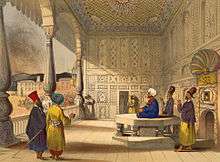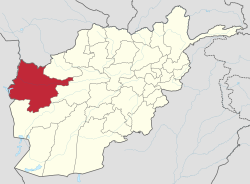Timeline of Herat
The following is a timeline of the history of the city of Herat, Afghanistan.
Prior to 15th century
- 500 BCE - Persian town in Aria established (approximate date).[1]
- 330 BCE - Artacoana captured by Alexander III of Macedon.[1]
- 167 BCE - Town becomes part of the Parthian Empire.
- 127 BCE - Town becomes part of the Kushan Empire
- 642 CE - Siege of Herat; Arabs in power.
- 1042 - City besieged by Seljuq Tughril.[2]
- 1064 - Alp Arslan in power.[2]
- 1102 - Earthquake.[3]
- 1163 - Bobrinski Bucket produced in Herat.[4]
- 1175 - Ghurids in power.[1]
- 1197 - Conflict between blacksmiths' and coppersmiths' bazaars.[2]
- 1201 - Construction of new Friday Mosque begins.[3]
- 1221 - City sacked by Mongols.[5]
- 1244 - Shams al-Din Kurt in power.[5]
- 1300 - Herat Citadel reinforced.
- 1364 - Earthquake.[3]
- 1380 - City taken by forces of Timur.[5]
15th-19th centuries
- 1405 - Capital of Timurid dynasty relocated to Herat from Samarkand.[4]
- 1410 - "Bazaars reconstructed."[4]
- 1425 - Tomb of Khwaja 'Abd Allah Ansari built at Gazurgah (near city).[6]
- 1438 - Gawhar Shad Mausoleum built.[4]
- 1448 - Siege of Herat (1448).
- 1460s - "Royal Canal" built.[4]
- 1469 - Sultan Husayn Mirza Bayqarah in power.[5]
- 1482 - Ikhlasiyya (educational and charitable complex) built outside city (approximate date).[7]
- 1500 - Friday Mosque rebuilt.[3]
- 1507 - Uzbek Muhammad Shaybani in power.[4]
- 1510 - City taken by Safavid Shah Ismail; Shamlu Turkomans in power.[5]
- 1528 - Safavid Shah Tahmasp in power.[5]
- 1716 - Abdali Afghan revolt.[5][8]
- 1729 - Nader Shah in power.[5][8]
- 1732 - Afghan revolt suppressed.[5]
- 1747 - City becomes part of the Durrani Empire.
- 1780 - Siege of Herat (1780-1781) begins.
- 1837 - 23 November: Siege of Herat by Persian forces begins.[5][8]
- 1842 - Alakozai Yar Muhammad in power.[8]
- 1851 - Syud Muhammad Khan in power.[8]
- 1855 - Muhammad Yusuf in power.[8]
- 1856 - Anti-Persian uprising.[9]
- 1857 - Persian control of city ends per Treaty of Paris;[5] Sultan Jan installed as ruler of Herat.[8]
- 1863
- 26 May: City taken by forces of Dost Mohammad Khan.[10]
- Mohammad Yaqub Khan in power.[8][11]
- 1880 - Abd al-Rahman Khan in power.[5]
20th century
- 1922 / 1301 SH - Solar Hijri calendar officially adopted in Afghanistan.
- 1925 - Herat National Museum established.
- 1947 - Radio Kabul transmissions begin to reach Herat (approximate date).[12]
- 1960s - Kandahar-Herat highway constructed.[5]
- 1973 - Population: 108,750.[13]
- 1979
- 1988 - Population: 177,300 (estimate).[15]
- 1993 - Mines cleared.[14]
21st century
gollark: School is at least pretty good at instilling mindless obedience!
gollark: Not *all* of it. And I think we should aim to reduce that.
gollark: That is indeed a word which you can put in quotes.
gollark: The trouble is that even an initially good measurement of how well you're likely to do a specific job is probably going to be distorted more and more the longer it's used as people try to optimize for it instead of actually being good at the job.
gollark: Apparently IQ correlates decently with some important things.
See also
- List of governors of Herat province
- Khorasan
- Timelines of other cities in Afghanistan: Kabul
References
- "City of Herat". UNESCO World Heritage Centre. Retrieved 16 April 2013.
- Paul 2000.
- Lisa Golombek (1983). "The Resilience of the Friday Mosque: The Case of Herat". Muqarnas. 1.
- Grove 2009.
- Bosworth 2007.
- Richard N. Frye (1948). "Two Timurid Monuments in Herat". Artibus Asiae. 11.
- Maria Eva Subtelny (1991). "A Timurid Educational and Charitable Foundation: The Ikhlāṣiyya Complex of Ali Shir Navai in 15th-Century Herat and Its Endowment". Journal of the American Oriental Society. 111.
- Balfour 1885.
- Mikhail Volodarsky (1985). "Persia's Foreign Policy between the Two Herat Crises, 1831-56". Middle Eastern Studies. 21.
- Stewart 1886.
- Marsh 1876.
- John Baily (1976). "Recent Changes in the Dutār of هرات". Asian Music. Society for Asian Music. 8.
- United Nations Department of Economic and Social Affairs, Statistical Office (1976). "Population of capital city and cities of 100,000 and more inhabitants". Demographic Yearbook 1975. New York. pp. 253–279.
- Tirard-Collet 1998.
- United Nations Department for Economic and Social Information and Policy Analysis, Statistics Division (1997). "Population of capital cities and cities of 100,000 and more inhabitants". 1995 Demographic Yearbook. New York. pp. 262–321.
- "Population of capital cities and cities of 100,000 or more inhabitants". Demographic Yearbook 2011. United Nations Statistics Division. 2012.
- "Table 8 - Population of capital cities and cities of 100,000 or more inhabitants", Demographic Yearbook – 2018, United Nations
This article incorporates information from the Russian Wikipedia.
Bibliography
- Published in 19th century
- Jedidiah Morse; Richard C. Morse (1823), "Herat", New Universal Gazetteer (4th ed.), New Haven: S. Converse
- Munshi Mohun Lal (1834). "Brief Description of Herat". Journal of the Asiatic Society of Bengal.
- Narcisse Perrin (1842), "Hérat", L'Afghanistan (in French), Paris: Bertrand
- J.P. Ferrier (1857), "(Herat)", Caravan journeys and wanderings in Persia, Afghanistan, Turkistan, and Beloochistan, translated by W. Jesse (2nd ed.), London: J. Murray
- Muhammad Isfizari (1861–63). Extraits de la chronique persane d'Herat [Extracts from the Persian chronicle of Herat] (in French). Translated by Barbier de Meynard. Paris: Imprimerie impériale.
- Hippisley Cunliffe Marsh (1876). "Description of a Journey Overland to India, via Meshed, Herat, Candahar and the Bolan Pass, in the Year 1872". Proceedings of the Royal Geographical Society of London. 21.
- George Bruce Malleson (1880). Herat: the granary and garden of Central Asia. W.H. Allen & Co.
- Edward Balfour (1885), "Herat", Cyclopaedia of India (3rd ed.), London: B. Quaritch
- C.E. Stewart (1886). "Herat Valley and the Persian Border, from the Hari-Rud to Sistan". Proceedings of the Royal Geographical Society and Monthly Record of Geography. 8 (3): 137. doi:10.2307/1800963. JSTOR 1800963.
- Charles Edward Yate (1888), "Herat and its Antiquities", Northern Afghanistan, Edinburgh: W. Blackwood & Sons
- "Herat". Brockhaus' Konversations-Lexikon (in German). Leipzig: Brockhaus. 1896.
- Published in 20th century
- "Herat", Encyclopædia Britannica (11th ed.), New York, 1910, OCLC 14782424
- Sayfi Harawi (1944). M.S. Siddiqi (ed.). Tarikh-nama-yi Harat (in Persian). Calcutta.
- A. Lezine (1963). "Herat, notes de voyage". Bulletin d'Études Orientales (in French). 18.
- Nancy H. Wolfe (1966). Herat, a pictorial guide.
- Paul English (1973). "The Traditional City of Herat, Afghanistan". In L.C. Brown (ed.). From Medina to Metropolis. Princeton: Darwin Press.
- D. Brandenburg (1977). Herat: eine timuridische Hauptstadt (in German). Graz.
- A.W. Najimi (1988). Herat, the Islamic City: A Study in Urban Conservation. London.
- Rafi Samizay (1989). "Herat: Pearl of Khurasan". Environmental Design: Journal of the Islamic Environmental Design Research Centre (1–2). Archived from the original on 24 December 2007.
- Felicia J. Hecker (1993). "A Fifteenth-Century Chinese Diplomat in Herat". Journal of the Royal Asiatic Society. 3.
- Olivier Tirard-Collet (1998). "After the War: the Condition of Historical Buildings and Monuments in Herat, Afghanistan". Iran. 36.
- Jurgen Paul (2000). "The Histories of Herat". Iranian Studies. 33 (1–2): 93–115. doi:10.1080/00210860008701977.
- Published in 21st century
- Josef W. Meri, ed. (2006). "Herat". Medieval Islamic Civilization. Routledge. ISBN 978-0-415-96691-7.
- C. Edmund Bosworth, ed. (2007). "Herat". Historic Cities of the Islamic World. Leiden: Koninklijke Brill. ISBN 978-9004153882.
- Michael R.T. Dumper; Bruce E. Stanley, eds. (2008), "Herat", Cities of the Middle East and North Africa, Santa Barbara, USA: ABC-CLIO
- "Herat". Grove Encyclopedia of Islamic Art & Architecture. Oxford University Press. 2009.
External links
| Wikimedia Commons has media related to Herat. |
- "Historic Cities Programme: Afghanistan". Aga Khan Trust for Culture. Aga Khan Development Network. Archived from the original on 21 May 2013.
- ArchNet. "Herat". Archived from the original on 26 October 2012.
- Map of Herāt and surroundings in 1942
This article is issued from Wikipedia. The text is licensed under Creative Commons - Attribution - Sharealike. Additional terms may apply for the media files.

